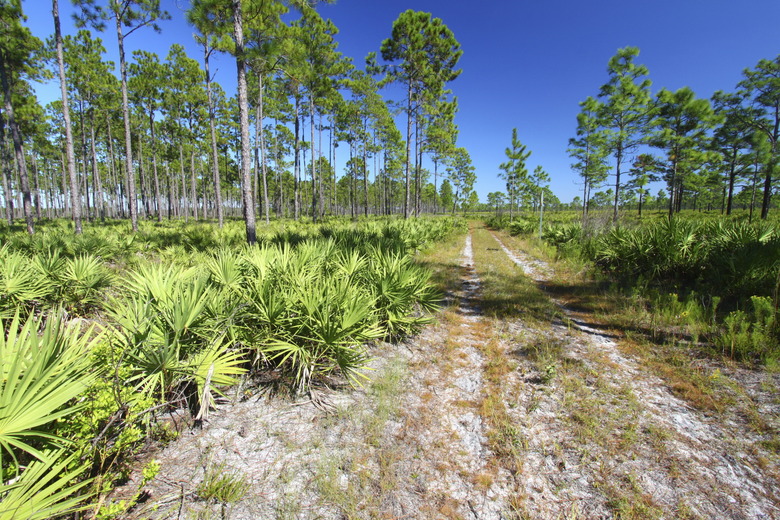How To Kill Palmetto Bushes
We may receive a commission on purchases made from links.
Saw palmetto (Serenoa repens) grows throughout the southeastern United States as scrubby plants that fill in the forest floor in their native habitat. A single plant features an array of fan-shaped fronds set atop multiple trunks that crawl along the ground, making it a full landscape shrub that can work as ground cover. If you decide you no longer want the palmetto bushes, removal can be challenging since established palmetto bushes are persistent and can continue growing after removal efforts.
Saw palmetto bushes are perennials in U.S. Department of Agriculture plant hardiness zones 8 through 11. The dwarf palm (Sabal minor), found in USDA zones 7 through 10, has similar growing habits and can be killed with the same approaches as used for saw palmetto.
Growth Habit of Palmetto Bushes
Growth Habit of Palmetto Bushes
Palmetto bushes grow slowly, reaching maximum heights of up to 8 feet tall. The multiple trunks grow in clumps, with mature clumps measuring up to 18 feet across. While the massive trunks can be seen above ground, they also have large, strong stems beneath the soil. Even when the visible portion of the plant is cut or otherwise killed, the plant remains alive in these underground stems and eventually grows new trunks and fronds above ground.
Cutting Palmetto Bushes
Cutting Palmetto Bushes
The woody trunks of palmetto bushes can be cut back to the ground when you want to get rid of the trunks and foliage immediately. A chain saw, hand saw or even an axe can be used to cut through the relatively soft trunks. In a clump measuring 18 feet across, there might be dozens of trunks to cut.
This doesn't completely kill the palmetto bush. Expect new growth within a couple of months. If you cut down the new foliage as soon as it grows, you can eventually kill the underground stems, because plants lack the ability for photosynthesis and storing energy in the underground stems. It could take several years to completely kill a large clump of palmetto bushes with this method.
Digging Palmetto Bushes
Digging Palmetto Bushes
Underground stems can't produce new shoots if you dig them out of the ground. Basic digging tools such as a shovel, mattock and pick axe are all you need to dig up the palmetto bush roots, but it is by no means an easy task. The dense clumps are difficult to dig around and can spread farther than the reach of the visible trunks above ground.
Cut the roots into smaller pieces with a pruning saw so they are easier to remove. A few root pieces are likely to remain no matter how carefully you sift through the soil, so monitor the area and dig up any new shoots. Add clean fill dirt to fill in the vacant spaces left after removing the roots.
Killing Palmetto Bushes With Herbicides
Killing Palmetto Bushes With Herbicides
Herbicide treatment is a much less labor-intensive method to kill palmetto bushes, but even this option proves difficult. The most effective herbicides are too strong for the home gardener to purchase and can only be applied by professional landscapers and arborists. Most herbicides available for home garden use are ineffective against palmetto bushes.
Triclopyr, a selective herbicide for shrubs, has been shown to provide 72-percent control when applied at a 4-percent solution. Triclopyr products are sold in different concentrations, but a product with 54-percent triclopyr, for example, should be mixed at a rate of 5 1/3 ounces to 1 gallon of water to achieve a 4-percent solution. This solution can be sprayed on the fronds and trunks, or you can cut the trunks and apply it to the cut surface. Repeat applications once monthly until no new shoots grow.
